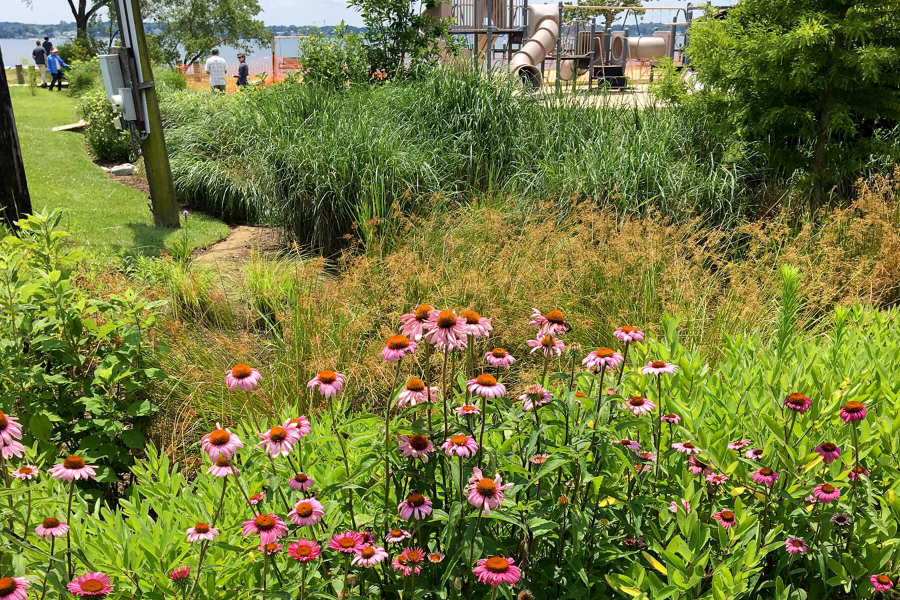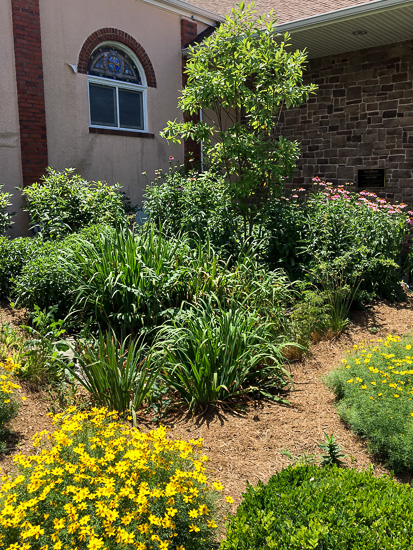Creating a cadre of Chesapeake Bay Landscape Professionals
New certification program provides credentials for sustainable landscaping

As I drove into the parking lot of the Mt. Olive African Methodist Episcopal (AME) Church in Annapolis on June 20, I couldn’t help but notice the rain gardens and lush native plantings on the church property. It certainly seemed appropriate, though, as I was there to attend a two-day training class with others aspiring to become certified as Chesapeake Bay Landscape Professionals (CBLP). The nascent CBLP Certification Program, in its first full year of operation, is a new voluntary credential system for professionals who design, install and maintain sustainable landscapes. The training and examination are based on a core set of standards in sustainable landscaping, emphasizing best practices for stormwater retrofitting and conservation landscaping to benefit the environment.
My class consisted of about 25 people representing a wide variety of environmental professionals. Some, like myself, had degrees in landscape architecture or regional planning, while others were horticulturists, arborists, engineers, ecologists or environmental scientists. While a bit eclectic, we were all there for two reasons: first, because we care about protecting and restoring the Chesapeake Bay and its rivers, streams and creeks, and second, to learn about the design, installation and maintenance of sustainable landscapes, with an emphasis on properly maintaining stormwater best management practices (BMPs). Consisting of a two-day class, an online webinar series and a written exam, the course incorporates interactive classroom instruction with a field-based practicum.
To begin our class, we were greeted warmly by Reverend Johnny Calhoun, pastor of our host Mt. Olive AME Church and one of the Chesapeake region’s leading advocates of involving faith communities in Bay restoration work. Thus inspired by the Reverend, we spent most of the day in the classroom with CBLP Program Coordinator Beth Ginter and our expert instructors learning about a variety of topics, including native plants, invasive species and soil textures. Following an overview of issues related to the design, installation and maintenance of stormwater BMPs, we finally headed outside for some field work.
We didn’t have to go far: the grounds of Mt. Olive AME Church served as a perfect venue for viewing first-hand some rainwater harvesting practices. For most places of worship, large parking lots are the norm, and Mt. Olive is no exception. To help limit stormwater runoff, church leadership put a number of practices in place, including three rain gardens lush with native plants and flowering perennials as well as some rain barrels to capture runoff from the church and community center roofs. They also installed pervious concrete in parts of the parking lot to help prevent stormwater from leaving their property and polluting local streams and rivers.
Day two of the CBLP training was spent primarily out in the field, participating in a “BMP Maintenance Practicum.” The CBLP management team decided that, regardless of whether a professional is going to focus on landscape design, installation or maintenance, it is imperative that everyone understand and properly plan for the maintenance needs and implications of sustainable landscapes. Armed with our inspection checklists, we spent the day examining various residential and commercial sites in and around the city of Annapolis.

Our first stop was the downtown Annapolis Visitors Center. We met with local landscape architect Shelley Rentsch, who designed the elliptical parking lot and bioremediation practices and plantings that surround it. Her design—which won a Best Urban BMP in the Bay Award, or BUBBA—uses a mix of rain gardens and their larger cousins, bioswales, as well as pervious concrete and permeable pavers for the parking spaces and driving surfaces. The conservation landscaping was generally in good shape, although our instructor was able to point out a few minor maintenance issues likely resulting from an inadequately trained maintenance crew.
Next was a green roof on top of a bank building off Westgate Circle. It was well-maintained and watered by a professional landscaping crew and had mainly low-growing, herbaceous plantings with some benches for workers to sit and enjoy the view of the city.
We then moved onto the Hillsmere Shores neighborhood, where we saw a number of good examples of somewhat larger-scale bioremediation projects on community properties (beaches, neighborhood pools, etc.), such as bioswales, step pool storm conveyances and raingardens. Most of them were well-established and professionally maintained, although we were told that annual maintenance costs are starting to raise concerns among some community residents.
We spent the remainder of the day touring other residential and commercial sites around the city, some of which had more serious maintenance issues (no names, please!). In a number of cases, it was hard to tell if the issues were the result of inadequate maintenance or of flaws in design or installation. But that was what the training was for: to get us thinking about these issues now, so we’ll each be prepared to address them in the future when we become certified Chesapeake Bay Landscape Professionals. We’ll know for sure after we take our certification exams this fall!

Comments
There are no comments.
Thank you!
Your comment has been received. Before it can be published, the comment will be reviewed by our team to ensure it adheres with our rules of engagement.
Back to recent stories